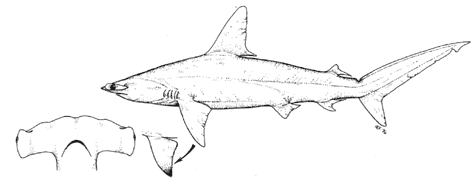Scalloped Hammerhead Shark(Sphyrna lewini)

(Griffith & Smith, 1834)
| Fr: |
Requin-marteau halicorne |
| Sp: |
Cornuda comun |
| It: |
Pesce stampella |
| Ma: |
N/A |
Diagnosis
A large (to over 300 cm), gracefully-proportioned hammerhead
shark with a broadly convex head measuring 24 to 30% of TL; its
anterior margin arched with a conspicuous central indentation,
a further prominent notch more laterally on each side.
Tooth count 15-16 (excluding small symphyseals) in each side of the
jaws; teeth smooth-edged or very weakly serrated. First dorsal fin
tall, measuring 11.9 to 14.5% of TL, with a rounded apex and falcate
in shape; its origin opposite or slightly posterior to the pectoral
insertions and with its free rear tip not extending rearwards to
above the pelvic fin origins. Posterior margins of pelvic fins
essentially straight. Second dorsal fin small and low, smaller than
the anal fin with its posterior margin roughly twice the fin height;
free rear tip long and extending almost to the precaudal pit.
Pectoral fins moderate in size, their anterior edges equating to
12.6 - 15.2% of TL. Dorsal colour mid brown-grey or bronzy-grey,
fading gradually to white ventrally. Apices of pectoral fins
noticeably dusky or black, particularly on their ventral surfaces;
also apices of ventral caudal lobe and second dorsal fin dusky in
juveniles.
Size
Maximum ca. 400 cm; mostly to 350cm; size at birth 42 to 55 cm.
Status & Distribution
Rather rare or occasional; restricted on current data to western
basin, principally near the Atlantic interface off Morrocco and
southern Spain; Alboran Sea and Algeria; sporadic further eastwards
to the Sicilian Channel although not reported from Malta. Probably
more cosmopilitan as occasional nomads, at least within the confines
of the western Mediterranean, but liable to misidentification with
other sympatric congeners.
Biology A coastal and semi-oceanic shark of warm temperate
and tropical seas, the scalloped hammerhead is a highly mobile,
migratory pelagic species occuring from the surfline to well
offshore, from tidal shallows and bays to depths of at least 275 m.
Juveniles are often found very close inshore. In many parts of the
world where these sharks are abundant (e.g., Red Sea; Sea of Cortez)
these hammerheads readily form large, mysterious schools which are
frequently orientated to submarine features such as seamounts. There
is no evidence of this behaviour in Mediterranean waters and capture
data, although presently sketchy, suggests a more sporadic and
diffuse population whose origins are Atlantic and Mediterranean
incursions essentially nomadic in nature. These sharks display a
high degree of complex intraspecific behaviours including a great
variance in swimming modes which may even involve complete
"corkscrew" rotations on their horizontal axis. These sharks may
occur in deeper water nocturnally for feeding, as demonstrated by
telemetry experiments off California. Piscivorous, feeding upon a
wide range of bony fishes including clupeids, jacks, small
scombrids, damselfish, conger eels, barracuda, gobies and
flatfishes; also elasmobranchs including smaller sharks, angelsharks
and rays; benthic and pelagic invertebrates, especially cephalopods
but also crustaceans and gastropods. A viviparous shark, with
litters between 15 to 30; females mature at about 212 cm TL and
males at ca. 140 to 165 cm.
The Shark Trust, 36 Kingfisher Court, Hambridge Road, Newbury, Berkshire, RG14 5SJ, UK.
Tel(+44) 01635 551150, Fax(+44) 01635
550230
|